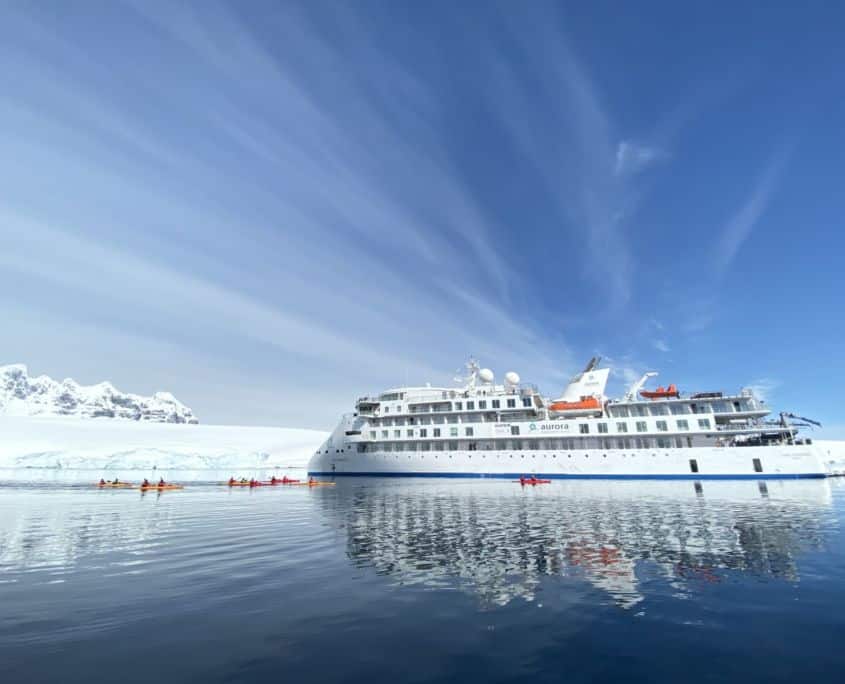Antarctica presents an extraordinary and otherworldly experience shaped by its extreme climate and impressive landscapes. Accessible primarily during the Antarctic summer, the continent offers 18-24 hours of daylight, ideal for experiencing the dramatic scenery of icebergs, glaciers, and vast ice sheets. Here, visitors will be met with unique wildlife such as penguins in their breeding season, seals, and whales. As the summer progresses into March, the weather begins to cool, the ice starts to refreeze and a different perspective comes to life. Visitors can enjoy the transition to the harsh Antarctic winter, and explore one of the planet’s most remote and pristine frontiers for a once-in-a-lifetime adventure.
Oaxaca
Mexico City
Travelling to Antarctica with True
Selecting the perfect exploration vessel is crucial to getting the best out of this once-in-a-lifetime experience. At True Travel, we only work with boats in Antarctica that meet our high standards of crew, guiding and service. Our team will discuss your wishes and select the best vessel for you.

Unlike many of Africa’s other safari orientated destinations, Botswana remains a destination that can be visited throughout the year.
The summer rainy season a viable time to travel, thanks largely to how well the rains drain through the sands of the Kalahari Desert that covers much of the country. This, coupled with amazing wildlife viewing and prices that can be less than half of what they are in the drier winter months, it is an incredible time to visit for those that don’t mind the heat and some rain storms.
That said, the traditional dry season months are still incredibly popular and offer some of the finest game viewing anywhere in Africa.
Local Time: GMT+2
Local Currency: Botswana Pula
21 Day Itinerary
Guide Price: £21,500pp
Guide Price: $25,800pp
Embark on an unforgettable Antarctic expedition from Ushuaia aboard the Sylvia Earle, delving into pristine landscapes on diverse excursions, learning from onboard experts about South Pole research, and concluding in the cultural embrace of San Antonio de Areca.
21 Day Itinerary
Guide Price: £19,100pp
Guide Price: $22,900pp
Embark on an exhilarating Antarctic expedition aboard a luxurious cruise, navigating through the breathtaking scenery of colossal icebergs and encountering diverse wildlife while learning about Antarctic exploration.
12 Day Itinerary
Guide Price: £12,500pp
Guide Price: $15,000pp
Explore Antarctica to uncover the singular essence of the polar terrain. Encounter wildlife amid penguin colonies, orcas, and minke whales, or dive into the icy blue waters for an immersive experience.
8 Day Itinerary
Guide Price: £12,200pp
Guide Price: $14,600pp
Take to the skies to embark on an exclusive Antarctica Air Cruise, soaring above the polar landscape to discover renowned sites like the Drake Passage and a diverse array of wildlife.
Duration: 21 Days
Guide Price: $25,800pp
Guide Price: £21,500pp
Destination:
Embark on an unforgettable Antarctic expedition from Ushuaia aboard the Sylvia Earle, delving into pristine landscapes on diverse excursions, learning from onboard experts about South Pole research, and concluding in the cultural embrace of San Antonio de Areca.
Duration: 21 Days
Guide Price: $22,900pp
Guide Price: £19,100pp
Destination:
Embark on an exhilarating Antarctic expedition aboard a luxurious cruise, navigating through the breathtaking scenery of colossal icebergs and encountering diverse wildlife while learning about Antarctic exploration.
Duration: 12 Days
Guide Price: $15,000pp
Guide Price: £12,500pp
Destination:
Explore Antarctica to uncover the singular essence of the polar terrain. Encounter wildlife amid penguin colonies, orcas, and minke whales, or dive into the icy blue waters for an immersive experience.
Duration: 8 Days
Guide Price: $14,600pp
Guide Price: £12,200pp
Destination:
Take to the skies to embark on an exclusive Antarctica Air Cruise, soaring above the polar landscape to discover renowned sites like the Drake Passage and a diverse array of wildlife.
Perfect For:
Duration: 20 Days
Guide Price: $38,000pp
Guide Price: £30,500pp
Destination:
Ernest Shackleton, a man who leaves behind him an incredible legacy, forging a journey across the Antarctic, into the Weddell Sea and onto South Georgia. This fascinating odyssey trace the movements of his famed expedition in a true commitment to adventure.
Perfect For:
Being in Antarctica is special, but it is the individual experiences that you will remember.
Picking out some of the highlights from Antartica, here are some of the experiences you have to look forward to.
The way you choose to explore Antarctica can completely determine the experience you go on. True Travel partners with the very best vessel operators, ensuring each trip we send to the Polar region is safe and exceptional.
Each trip True Travel curate is based on the experience you are looking for and as an independent travel operator, we are not obliged or committed to any properties. You can rest safe in the knowledge that the accommodation we recommend for your stay has been chosen based on your interests, not ours.
Featured
Seaventure is an 82-cabin vessel and a fantastic option for a small ship experience with a good dose of adventure. She features a 1-A Super ice-class rating (the highest category available), meaning that she can explore coves, bays and channels that would previously have been off-limits.
Featured
The Magellan Explorer is a good choice for anyone wanting to skip 4 cruising days of the Drake Passage crossing. One of the few fly-cruise options available, this luxury ship in Antarctica has a capacity for 76 guests in seven cabin categories and 10 zodiac boats for accessing land excursions.
Featured
Named after the great American biologist and conservationist, The Sylvia Earle launches in November 2022 as a carbon-neutral ‘Floating Ambassador for the Planet.
Whether you choose to set off on your Antarctica adventure from Argentina or Chile, you’ll have the opportunity to pass a number of remote islands in the South Atlantic Ocean.
The South Shetland Islands are about 200 km north of the Antarctic Peninsula. There are more than 20 wild islands in the archipelago, including King George Island, where several scientists and research stations are based. Several whales, seals and penguins frequent these coastal shores providing incredible opportunities for wildlife photography. Over 80% of the islands are glaciated, and the towering black rocks that punctuate the landscape contrast with the shocking white of the ice and snow.

SIGN UP